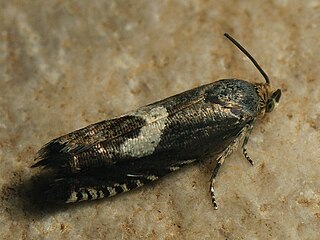Helcystogramma pantheropa is a moth in the family Gelechiidae. It was described by Edward Meyrick in 1913. It is found in South Africa.
Dichomeris oleata is a moth in the family Gelechiidae. It was described by Edward Meyrick in 1913. It is found in Mpumalanga, South Africa.

Dichomeris crambaleas is a moth in the family Gelechiidae. It was described by Edward Meyrick in 1913. It is found in Taiwan and Assam, India.
Dichomeris ferruginosa is a moth in the family Gelechiidae. It was described by Edward Meyrick in 1913. It is found in Assam in India, Zhejiang in China, Taiwan, Java in Indonesia and Japan.

Dichomeris summata is a moth in the family Gelechiidae. It was described by Edward Meyrick in 1913. It is found in Assam in India, Yunnan in China and in Taiwan.
Dichomeris caerulescens is a moth in the family Gelechiidae. It was described by Edward Meyrick in 1913. It is found in Assam, India.
Dichomeris pelitis is a moth in the family Gelechiidae. It was described by Edward Meyrick in 1913. It is found in Assam, India.
Dichomeris malachias is a moth in the family Gelechiidae. It was described by Edward Meyrick in 1913. It is found in Assam, India.
Dichomeris immerita is a moth in the family Gelechiidae. It was described by Edward Meyrick in 1913. It is found in Sri Lanka.
Dichomeris corniculata is a moth in the family Gelechiidae. It was described by Edward Meyrick in 1913. It is found in Assam, India and Guangdong, China.
Dichomeris procrossa is a moth in the family Gelechiidae. It was described by Edward Meyrick in 1913. It is found in southern India.
Dichomeris citharista is a moth in the family Gelechiidae. It was described by Edward Meyrick in 1913. It is found in southern India.
Dichomeris ferrata is a moth in the family Gelechiidae. It was described by Edward Meyrick in 1913. It is found in Assam, India.
Dichomeris excoriata is a moth in the family Gelechiidae. It was described by Edward Meyrick in 1913. It is found in Assam, India.
Dichomeris olivescens is a moth in the family Gelechiidae. It was described by Edward Meyrick in 1913. It is found in Sri Lanka.
Dichomeris stratellus is a moth in the family Gelechiidae. It was described by Walsingham in 1897. It is found in the West Indies and Trinidad.
Dichomeris lissota is a moth in the family Gelechiidae. It was described by Edward Meyrick in 1913. It is found in Assam, India.
Dichomeris macrosphena is a moth in the family Gelechiidae. It was described by Edward Meyrick in 1913. It is found in São Paulo, Brazil.
Dichomeris percnacma is a moth in the family Gelechiidae. It was described by Edward Meyrick in 1923. It is found in Peru and Amazonas, Brazil.

Grapholita orobana is a moth belonging to the family Tortricidae. The species was first described by Georg Friedrich Treitschke in 1830. It is native to the Palearctic.


